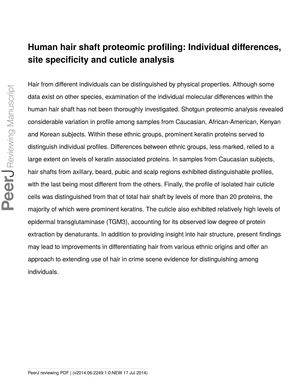Human Hair Shaft Proteomic Profiling: Individual Differences, Site Specificity, and Cuticle Analysis
August 2014

TLDR The research found that people's hair proteins vary by individual and body part, with some differences between ethnic groups, which could help in forensics.
The study conducted shotgun proteomic analysis on human hair shafts and found significant individual variation in protein profiles among samples from different ethnic groups, including Caucasian, African-American, Kenyan, and Korean subjects. Within these groups, keratin proteins were key in distinguishing individual profiles, while differences between ethnic groups were less pronounced and mostly based on levels of keratin-associated proteins. The research also revealed that hair from different body sites (axillary, beard, pubic, and scalp) of Caucasian subjects had unique profiles, with scalp hair being the most distinct. Additionally, the protein profile of the hair cuticle was notably different from the total hair shaft, with a higher presence of keratins and epidermal transglutaminase (TGM3), which contributes to the cuticle's resistance to protein extraction by denaturants. These findings could enhance methods for differentiating hair from various ethnic origins and improve the use of hair in forensic science for distinguishing individuals.

